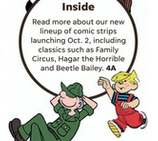The Gannett History of Comic Strips
Skip to comments“In the first half of the 19th century, newspapers had been around for centuries but had very few images because images had to be engraved or etched. By the second half of the century, they were becoming more visual.”
Columbus Dispatch reporter Belinda M. Paschal with major assistance from Jenny Robb, head curator of the Billy Ireland Cartoon Library & Museum, and Jared Gardner, the Joseph V. Denney Designated Professor of English and director of popular culture studies at OSU, presents a brief (actually rather lengthy for a newspaper article) and very good outline of the history of American newspaper comic strips for a front page feature intended for and published in many Gannett/USA TODAY Network newspapers today.

The feature article can be read at The Coloradoan, some excerpts below:
Joseph Pulitzer’s sensationalistic New York World was one of the first newspapers to publish comic strips, beginning around 1890. Many noteworthy comic strips were born in the World, including Ohio-born Richard F. Outcault’s “Hogan’s Alley,” considered the first commercially successful newspaper comic strip.
“Suddenly, there are newspaper syndicates — the Hearst Syndicate, the King (Features) Syndicate. Comics could be published across the country and every day on the same day, everybody would read the same comics. This became, really, the first national water cooler talk!”
… Still, the world of mainstream comics remained largely white. As the fight for racial equality intensified, Black cartoonist Morrie Turner began questioning the lack of people of color in the comics. His friend and mentor, Peanuts creator Charles M. Schulz told him, “You should do a strip,” according to Robb.
In the early 20th century, the comic strip “Lucy and Sophie Say Goodbye” walked so contemporary artists like Alison Bechdel and Lynn Johnston could run … Lucy and Sophie’s farewells, which always held up urgent business bustling around them, initially included a kiss obscured by their Belle Époque-style hats. But as the strip continued, their kisses and embraces became less ambiguous and decidedly more passionate.
Other strips have been the target of ire, most notably Garry Trudeau’s “Doonesbury,” which has been withheld or given the boot altogether a handful of times in its 50-plus years of existence. “When (Trudeau) declared the Watergate conspirators to be ‘guilty, guilty, guilty,’ a lot of papers were upset,”
“In the last 20 years, we’ve been seeing many artists move entirely to digital art. There’s no originals; it’s all bits and bytes,” she said.
As seen by the above brief quotes the newspaper feature admirably covers the entire history of newspaper comic strips and panels. A recommended read before moving on to the various comic history books by Brian Walker, Ron Goulart, Maurice Horn, and others.
feature photo by Barbara J. Perenic/The Columbus Dispatch


Comments 2
Comments are closed.